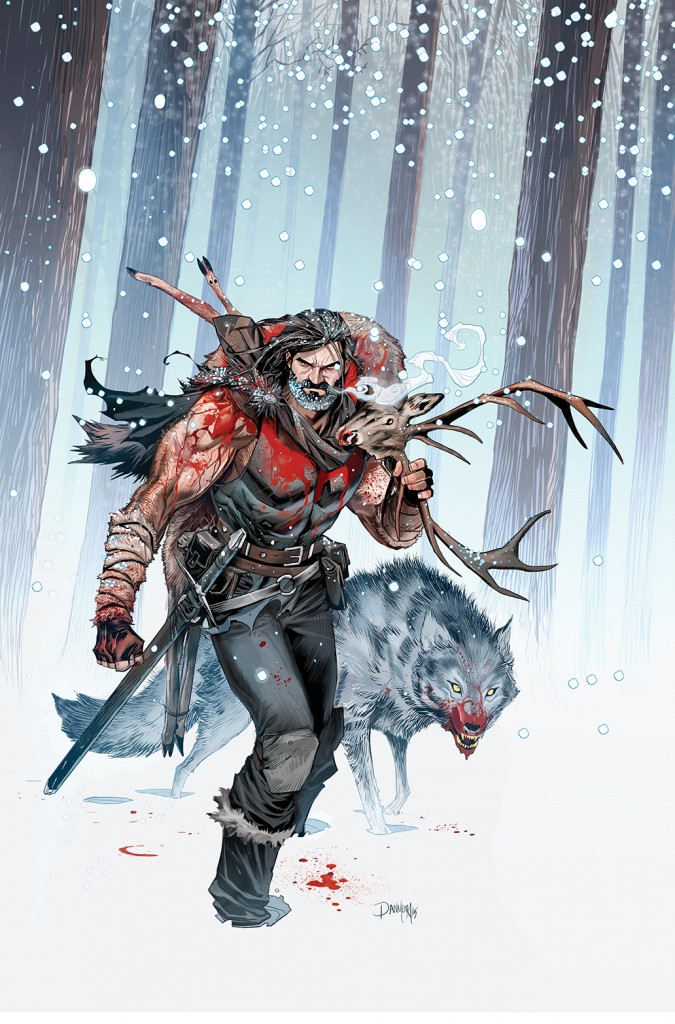 By Jarrod Jones. For millions of children around the world, Santa Claus is very real. And I promise you, if Santa Claus looked anything like he does in Grant Morrison and Dan Mora’s Klaus, I would believe in him too. (I can just picture his hard-assed blood-and-snow-flecked beard wrapped around collector’s bottles of Coca-Cola. What a better world that would be.)
By Jarrod Jones. For millions of children around the world, Santa Claus is very real. And I promise you, if Santa Claus looked anything like he does in Grant Morrison and Dan Mora’s Klaus, I would believe in him too. (I can just picture his hard-assed blood-and-snow-flecked beard wrapped around collector’s bottles of Coca-Cola. What a better world that would be.)
Not so long ago Grant Morrison promised Comic Book Resources (and thus, the world) that his bonkers Santie Cwaus tale would be the origin story for ol’ St. Nick you never knew you needed. (“Basically, this is my ‘All-Star Santa Claus.’“) So if it ever occurred to you that, no, you never really knew how Santa Claus acquired his trademark sack, or how he earned the trust of reindeers, you can rest assured that Grant Morrison’s got your back. The Zero Year of Santa Claus is upon us. And it’s far more entertaining than it has any right to be.
I’m placing the blame squarely on Dan Mora. Klaus #1 has plenty of Morrison’s reliably out-there motifs, and it’s done quite a service by them, but Mora’s renderings make this book one thousand times more visceral than anyone could have predicted. (And he gave us a cover so metal, I can only hear death growls when I stare at it.) Mora’s Klaus may be a gentle giant living in the iced-over wilderness outside a beleaguered town called Grimsvig, but the artist places enough danger on the brow that rests over his warm, chestnut eyes to remind us this is not a man to be trifled with. Mora’s painterly hues swathe the reader in soft, winter palettes one moment, and then shake the safety right out of you in shocks of blood red the next.
If I’ve gleaned one thing from this mighty opening salvo, there’s a danger to Klaus that has yet to reveal itself. Sure, there’s the Lannisterian Lord Magnus and his dissatisfied ruling family (young Master Jonas is a more angular Joffrey analogue if I ever saw one), but their seething antics serve more to establish their cartoonish malice than anything else. A reckoning between Klaus and Magnus is only inevitable; fortunately we’re talking about Grant Morrison here, who is only too aware of this, and is reliably prepared to toss his patented curveballs all over the place before this series comes to its climax. There are few surprises to find in Klaus beyond its unabashed entertainments. And yet, that’s perfectly fine.

More intriguing is the Lady Dagmar, who holds the tradition of Yuletime so sacred that her palpable disdain for her family doesn’t preclude them from sharing a banquet feast. The mother to Magnus’ rotten whelp, Dagmar has a great desire to escape her present station, one that’s nearly betrayed by the lidded gaze Mora provides her. (Morrison offers his flourishes too: Dagmar’s passive “Hm.” upon hearing news of the hairy savage just outside her walls pegs her as the future Mrs. Claus, just in case you weren’t paying attention.) Since Klaus is set in a brutal medieval setting (which may as well be set in the Bulgarian Empire, far what it’s worth), we know that Dagmar is designated a subservient place by the patriarchy. But Mora and Morrison provide just enough simmering heat underneath her placid face that there’s hope to see her unleash her fury yet.
Morrison & Mora give the origin story that is Klaus a nigh-Kryptonian strength. Garbed in a red hood that drapes over his broad shoulders just so, our hero inevitably develops a superpower all his own (one of which I won’t spoil here). Whether or not he makes it to the very end of this promising saga (he is a Saint, after all) is beside the point. Morrison has tackled yet another iconic character and lent him the sobering dignity popular media can scarcely afford. If this is indeed the Mad Scotsman’s All-Star Santa, we can rest assured there’s more to enjoy from his legend of Klaus: Who He Is, And How He Came To Be.
BOOM/$3.99
Written by Grant Morrison.
Art by Dan Mora.
Lettered by Ed Dukeshire.
8.5 out of 10













